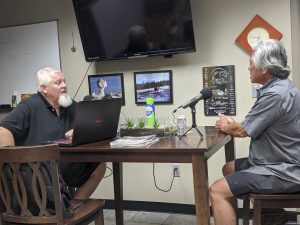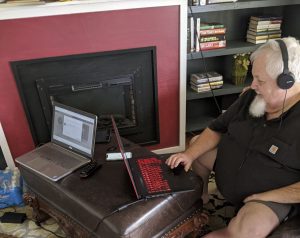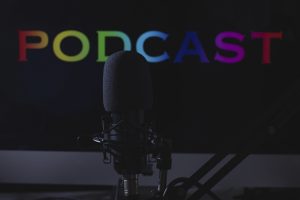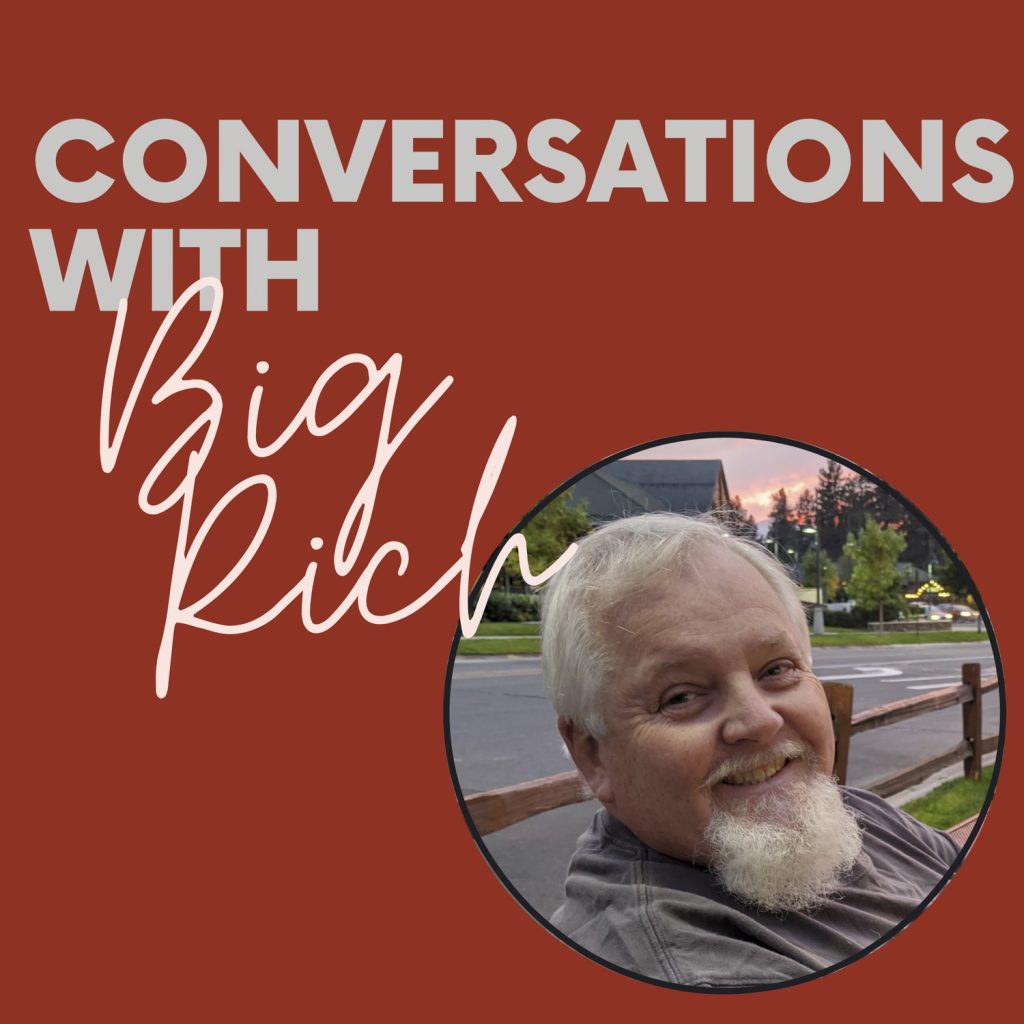Man Cave Conversations
Podcast Mania
Story by Shelley Krehbiel
The Man Cave feature is intended to tell you about stuff you may not know already. We like a wide variety of things and assume that you do too.
 Over 2,000,000 podcasts exist – audit is all the rage! We’ve told you about them before, who to listen to, how to listen, but since then, maybe you’ve decided you want to produce a podcast. Truly, there is nothing stopping you. Podcasts are perfect for the Average Joe. There is a low barrier to entry, they are fun, and you could start today. A word of caution though, if you want to do it “right,” they can be pretty time-consuming.
Over 2,000,000 podcasts exist – audit is all the rage! We’ve told you about them before, who to listen to, how to listen, but since then, maybe you’ve decided you want to produce a podcast. Truly, there is nothing stopping you. Podcasts are perfect for the Average Joe. There is a low barrier to entry, they are fun, and you could start today. A word of caution though, if you want to do it “right,” they can be pretty time-consuming.
Our podcast just released its 69th episode – that’s once a week for well over a year. Like the magazine, we are consistent with its release. That doesn’t mean we don’t struggle a bit to find the time to make it happen, but each Thursday at 2 a.m., a new episode of Conversations with Big Rich gets released. We’d invite you to listen if you are interested in the history of off-road.
This space is going to share what it takes to get started based on our experiences. There are lots of resources out there – start with this list, then go to YouTube to flesh out your education.
Steps to starting a podcast
- Figure out what you want to talk about. There are many successful podcasts that seem completely random, but like most things out in the world, unless you are a celebrity, you probably need to niche down to find people who will listen to you.
We choose the history of rockcrawling and off-road as our topic. For us, it was more about leaving a legacy than reaching the whole world. We wanted to be sure we interviewed those who were around at the beginning of the sport. Rich talks to drivers, spotters, sponsors, media, business owners, essentially anyone who has made an impact in the four-wheel-drive industry. The stories that come out are our favorite part; we get to know the person better than we ever would in casual conversation over many years.
You should talk about what interests you. No doubt there is an audience for it. Any topic is fair game in the podcast world.
- Decide the format you want to have. Interviews are great if you can connect with others (honestly, this is tough sometimes – people’s schedules are busy). You could also have a co-host and just have a conversation between the two of you. Another choice is a solo podcast where you just talk. Any of those work. I think it’s harder to have more than two people because you tend to talk over each other that way, but it’s been done. Pick the format that works for you.
We use an interview format – generally Rich and the guest, sometimes two guests at a time if they are connected – like a team.
- Figure out how to record the podcast. If doing an interview, you could do a Zoom call and include video for a release on YouTube; or just a phone call would do. You could do in-person interviews; those are fun. The important part is good quality sound; your listeners need to be able to hear clearly. Sound can be affected by your environment or your equipment. Make sure the equipment is good, so you only have to worry about the environment.
Rich uses a Zoom P4 to record. He plugs in his iPhone to it, and it records the voices on separate tracks – this matters when you go to edit. He also uses a good microphone, the Q2U, not a Blue Yeti – which everyone uses, but a comparable one. It serves him well. Check your sound before you make the call. Be sure you know how the P4 works, where to plug it in, that kind of thing. You want your interview to go smoothly. This format records on to a memory card that we move to the computer for editing.
- What other steps will you take besides recording? There are a bunch of choices to make here: will you edit the recording? Will you create a transcript? Will you write show notes? Do you need to gather pictures? Now that you have the recording, what happens next?
We can share our experience; if we were starting over, we might change how we do this – but now that we’re in, we’re sticking with the plans we made; after all, we made each of these decisions for a reason. This is the time-consuming part. After the recording, Rich edits the podcast. We don’t release it live, so we have time to edit. Editing takes out the false starts, the fumbles, the umm’s and ahhh’s. It doesn’t take long in a conversation to notice people’s speech patterns and crutches; we try to remove the excess to make the listener’s experience better. We edit in Adobe Premiere Pro. There are other editing programs that are less expensive, but since we use the Adobe Suite for many other parts of our business, it makes sense to use it here.
After editing, we also have a transcript done. This helps those who are hearing impaired to be able to read the interview. We use AI software for the transcript, so it isn’t perfect. I’d say it runs about 70%. Then I edit the transcript to get it closer to 90%. There will still be some errors, but you could read it and understand what is said. We use Happy Scribe for the transcript. From that transcript, we also write Show Notes. These are just little blurbs that let the listener know what to expect. It’s also the place to put your guests’ website.
- Where will you post your podcast? We opted to use Buzzsprout; it’s simple to use, they have access to all podcast carriers, and it’s a reasonable cost. There are other hosts: Lisbyn, PodBean, Sound Cloud, to name a few. Pick the one that works for you.
 Once you have your first episode created, you upload it to the software, and then you can apply to get listed on all the Podcast apps. The most important being iTunes. But there are others; there is no reason not to apply to all of them. For us, Buzzsprout made that easy. You just click on each icon on their screen and give it the info it asks for.
Once you have your first episode created, you upload it to the software, and then you can apply to get listed on all the Podcast apps. The most important being iTunes. But there are others; there is no reason not to apply to all of them. For us, Buzzsprout made that easy. You just click on each icon on their screen and give it the info it asks for.
In addition to having Buzzsprout host our podcast, we also post on our website and our page on Facebook. This helps reach the people we want to listen to the podcast.
- Why do you want a podcast? This probably should have been the first question asked, not the last, but if you’ve gotten this far and realize how much work is involved, maybe now is the best time. If you want a podcast to get famous, you better be good at marketing. If you want a podcast to get rich, you better be good at marketing. If you want it to tell a story, you’re in the right place. Podcasts are a great source of information, a great way to share information, and fun to do.
We highly recommend you do it, don’t feel like you have to be somebody to have a successful podcast, and measure success your own way. Remember 20 downloads is like speaking to a full classroom, 200 to a hotel convention room, 400 to an auditorium. It may not feel like anyone is listening, do it anyway.
 If you have no interest in hosting a podcast but want to listen instead, download an app to your phone. iTunes comes loaded on iPhones, Android users have more choices, but Stitcher or Spotify seem to be the most popular. You can also play podcasts on Alexa in your home. If you are traveling, they are a great way to stay entertained and informed while you are on the road. The most listened-to podcast ever is The Joe Rogan Experience, the most popular genre is True Crime.
If you have no interest in hosting a podcast but want to listen instead, download an app to your phone. iTunes comes loaded on iPhones, Android users have more choices, but Stitcher or Spotify seem to be the most popular. You can also play podcasts on Alexa in your home. If you are traveling, they are a great way to stay entertained and informed while you are on the road. The most listened-to podcast ever is The Joe Rogan Experience, the most popular genre is True Crime.- Recommended podcasts about four-wheel drive: Conversations with Big Rich, The Talent Tank, ModernJeeper, The 4×4 Podcast, TrailChasers – there are others, go explore.

